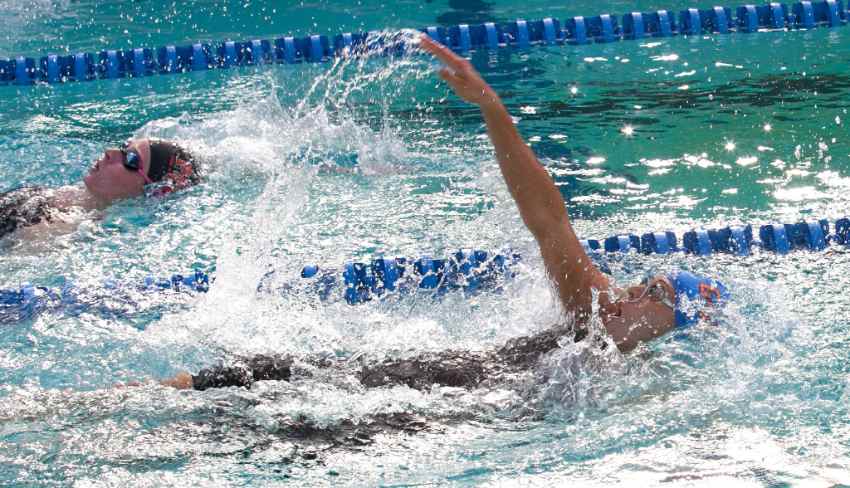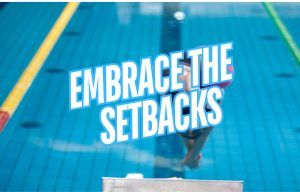One of the best strategies for improving rapidly in the water requires you to break apart your Big Goal like a 300-year old foam pull-buoy. Here’s why you should pull your Big Goal apart to maximize progress.
There is a TON of utility in having big goals.
They inspire us, motivate us, and sharpen our focus when we wrap our toes around the edge of the pool deck.
But there will be moments over the course of the season where things aren’t progressing as fast as they should.
Or you’re feeling overwhelmed with all the work that is still to be done.
In times like this, it can be extremely helpful to break your goal apart.
Read on, and I will explain what I mean, give a detailed pair of examples, and provide a couple of next steps for you to take action.
Let’s dive in.
The Difficulty of Really Hard and Really Awesome Goals
The enormity of a goal is both exhilarating and daunting.
Exhilarating because we think of how much change we will incur to get there, the satisfaction we will experience in the moment, and the pride of the accomplishment.
Daunting because it will require more effort of us than ever, is not guaranteed to happen even if we do work hard, and the thought of failing on our face when it’s time to race.
Setting the big goal is rarely the difficulty.
It’s doing the work along the way in a sustainable manner to help us maximize the time we have.
And one way to keep your effort consistent and energy focused is by breaking apart your goals.
The Power of Going Granular with Your Goals
I’m going to give you a couple of examples of how breaking apart your big goals can help you make progress, faster.
? Example 1 – Increasing Total Distance Swum at Practice
You are currently the kind of swimmer who does 3,000m at swim practice. It’s a challenge to get there, but you do it.
Now, let’s say you want to be the swimmer who wants to swim 6,000m.
First, your current conditioning levels mean you will be absolutely wrecked after doing a 6k workout.
And you may be able to do it once, maybe twice before the walls cave in on you. This kind of overnight escalation is unsustainable.
Instead of wrecking yourself, break apart that goal of 6k and spread it out.
The next few weeks could look something like this:
- Week 1: 3,000m
- Week 2: 3,500m
- Week 3: 4,000m
- Week 4: 4,500m
- Week 5: 5,000m
And so on.
This example is very simplified and perfectly linear.
In reality, you would actually require some recovery weeks to help you bounce back as the meters continue to climb. And you might even need two weeks of 4k workouts to build up the proper conditioning to get to the next level.
But this example should give you an idea of how you can break apart a distance-focused goal.
? Example 2 – Race Pace Training
Here is another example.
Let’s say you have a goal of swimming a :56 in the 100 freestyle this season.
To get there, you know that you need to bang out a whole boat-load of race pace specific reps in training.
In this case, race pace is:
- :28 for a 50
- :14 for a 25
Being able to hit this pace repeatedly in training will give you the confidence on race day to perform.
With your goal pace in hand, you head down to the pool, strap your favorite set of swim goggles on your face and jump in the water race pace 50s at a pace of :28 per rep.
The red :60 comes around, you push off, swim your little heart out, and the pace clock spits out a :29.
Same thing on the next rep.
And then a :30 on the following rep.
Over and over, you “fail” at hitting the race pace, which, for obvious reasons, gets equal parts frustrating and disheartening.
Well, shucks. What are ya gonna do?
Break it down to another level is what.
Do 25s aiming at swimming them in :14 or faster.
Here is an example of how this could play out:
- 20×25 race pace @:40 (Results: Made 17/20)
- 20×25 race pace @:40 (Results: Made 20/20)
- 20×25 race pace @:35 (Results: Made 16/20)
- 20×25 race pace @:35 (Results: Made 19/20)
- 20×25 race pace @:30 (Results: Made 9/20)
- 20×25 race pace alt @:30/:@:35 (Results: Made 15/20)
- 20×25 race pace alt @:30/:@:35 (Results: Made 19/20)
- 20×25 race pace @:30 (Results: Made 16/20)
And so on.
With time, you replicate the same thing with 50s.
- 20×50 race pace @1:10 (Results: Made 4/20)
- 20×50 race pace @1:20 (Results: Made 11/20)
- 20×50 race pace @1:20 (Results: Made 15/20)
- 20×50 race pace @1:20 (Results: Made 19/20)
- 20×50 race pace @1:10 (Results: Made 12/20)
- 20×50 race pace @1:10 (Results: Made 16/20)
- 20×50 race pace @1:00 (Results: Made 9/20)
And so on.
As the success rate goes up, we increase the difficulty (hence the descending intervals in this example), ensuring that progress is perpetually being made (or at least attempted).
This form of improvement is not particularly glamorous.
There is “failure” riddled throughout.
But those misses are outweighed by the makes.
And they are far less demoralizing than not breaking the challenging goal down further.
At the end of the day, with this approach, you are steadily building your capacity to accomplish your goal by breaking it apart.
Breaking apart your goals can win the day in just about every other avenue of your swimming:
- Instead of overhauling your entire diet, you could break it down into packing a protein shake for a post-workout snack and carrying a bottle of water with you at all times.
- Instead of resolving to be the mentally toughest athlete in the pool, you would break it down by picking a mantra (“I will not be outworked!”) to use in moments of adversity.
- Instead of deciding to be the swimmer who never cracks under pressure, you would break it down by finding one thing you can compete on at practice to better inoculate yourself to pressure.
And so on.
Breaking down goals makes them more manageable, keeps you from dipping too low when things aren’t progressing as fast as you would like, and honestly, is just more fun!
After all, breaking apart your big goal gives you lots of little wins to stack up instead of perpetually stressing about what may or may not happen on race day.
The Next Step
Now, the moment of action!
Let’s take this strategy and put into action.
Take your Big Goal and pull out a pair of hedge clippers and get to chopping it up into smaller, measurable, and actionable steps.
Remember: If you are constantly failing, break it down a level further until you can start accumulating some W’s to build momentum.
Big Goals are a lot of fun to set, but the real fun comes in breaking them apart and becoming the swimmer you’ve always dreamed you could be through hard work and smart focus.
More Stuff Like This
This Mental Training Workbook Will Help You Swim Like a Rock Star This Season. Confused about mental training? Want to unleash pro mode on your swimming this year? Learn how this mental training workbook will change your mindset and help you pummel your PB’s this season.
Why Change is So Hard in the Pool (and How to Make It Easier). We all want change in some measure—so why is it so dang difficult to make happen? Here’s the reality behind making change that actually sticks in the pool.














